#in The Next Generation they assimilate Captain Picard and turn him into Locutus of Borg so they can use him to try and assimilate Earth
Explore tagged Tumblr posts
Text
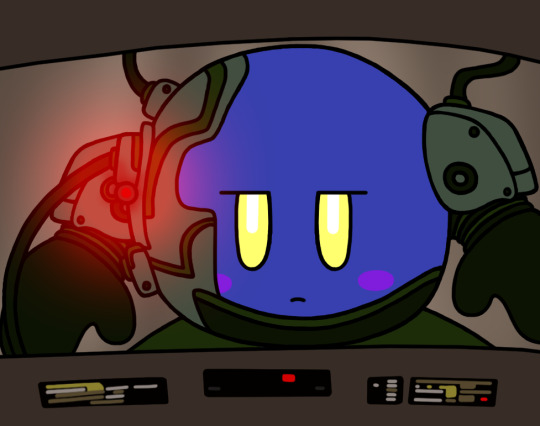
I didn’t have time to draw something for Halloween, so here’s this old drawing I did a while ago of Meta Knight as Captain Picard/Locutus of Borg from Star Trek: The Next Generation that I feel somewhat fits the Halloween theme. I call him Locutus of Borb.
#Kirby#Kirby fanart#my art#Meta Knight#I don’t think this looks very good this was one of my first Kirby drawings and I was still figuring out how to draw everyone#I’ll probably redraw this eventually but still wanted to share this since I didn’t have time to draw anything for Halloween#aside from being a Kirby fan I’m also a big fan of Star Trek I’ve seen all the shows and movies#and I see a lot of parallels between Star Trek and Kirby#literally the whole plot of Planet Robobot is just the Borg storyline in Star Trek lol#for Kirby fans who don’t follow Star Trek the Borg are a collective of cyborgs that can essentially mechanize other species#they appear as recurring antagonists and attempt to assimilate other species into their collective against their will#and once they’ve assimilated a person they can influence that person to do their bidding#in The Next Generation they assimilate Captain Picard and turn him into Locutus of Borg so they can use him to try and assimilate Earth#it reminded me a lot of what Susie did to Meta Knight in Planet Robobot so that’s where the idea for this drawing came from#I’ll have to draw more Star Trek and Kirby crossover stuff there’s a lot I can work with for crossovers lol#like Star Trek straight up has a mirror universe full of evil versions of the characters that’s literally just Amazing Mirror#and the episode of the anime where Dedede gets the Scarfies as pets is basically just the Tribble episode from Star Trek#anyways happy Halloween please enjoy Locutus of Borb
19 notes
·
View notes
Text
Why did the Borg assimilate Picard instead of Worf or Data?
Star Trek The event you’re referring to occurred in the Star Trek: The Next Generation two-part episode called “The Best of Both Worlds.” In that storyline, the Borg captured Captain Jean-Luc Picard and assimilated him into their collective, turning him into the Borg spokesperson known as Locutus. The Borg chose Picard for several reasons: 1. Strategic Value: As the captain of the USS…

View On WordPress
#international world india AntipoloCity travel game fashionblogger dream worldwide gameday attraction movies movie captain tv#usa canada usa europe australia
0 notes
Text
Reviewing Star Trek TNG - S4E1 "The Best of Both Worlds - Part 2"

PREVIOUSLY ON STAR TREK: THE NEXT GENERATION...
...Just read my last review. Or watch the episode for yourself.
And now, the thrilling conclusion!
WHAT'S IN STORE IN SEASON 4?
...A few of the producers left…
…Jeri Taylor joined as a supervising producer and part of the writing crew… she co-created Voyager a few years later… I guess that’s kind of important…
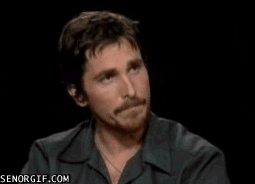
Okay, how about I finally review this fucker?
MY REVIEW
"Mr Worf... fire."
The energy beam fires… and has no effect.
Four months of waiting well spent.
It turns out that assimilating Picard into Locutus added his knowledge and experience to the Borg's hive mind, so they know every possible move the crew is about to make. With the crippled Enterprise no longer posing a threat, the Borg continue on their course to Earth.
Admiral Hanson tries to reassure them that there's no way Picard is helping the Borg - despite significant evidence to the contrary - and gives Riker a field promotion to captain.
One of this episode's biggest strengths is its tension, since at the time audiences had no guarantee that Picard was going to make it out of this. It seemed entirely possible that Riker was going to take over as captain, with Shelby as his first officer.
Obviously said tension is now practically nonexistent with the knowledge that Picard went on to appear in four more seasons, four movies, an episode of Deep Space Nine and a three-season spinoff series with his name on it, but I digress.
Nevertheless, morale is running low throughout the entire ship, with the crew scrambling to repair the ship and find new means to combat the Borg and Riker feeling immense pressure to perform in a position he was unprepared for. Sensing that the crew is overwhelmed, Guinan comes to visit him, in an interesting parallel of the scene from part 1.
Guinan: When a man is convinced he's going to die tomorrow, he'll probably find a way to make it happen. The only one who can turn this around is you.
Riker: I'll do the best I can.
Guinan: You're going to have to do something you don't want to do. You have to let go of Picard.
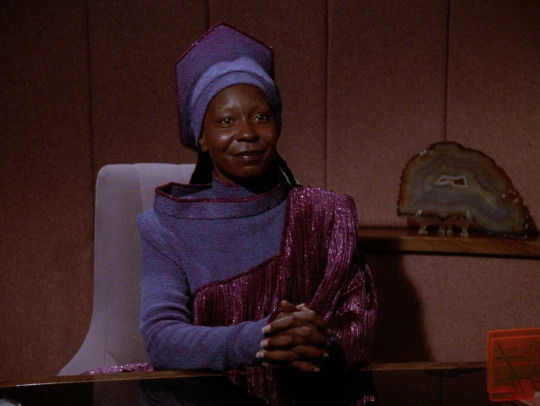
To clarify, she means that they can't let the loss and influence of the captain hang over them, and that Riker has to let him go and be his own captain if he has any hope of defeating Locutus.
Before Riker can give it any more thought, the Enterprise arrives at the battle coordinates at Wolf 359.
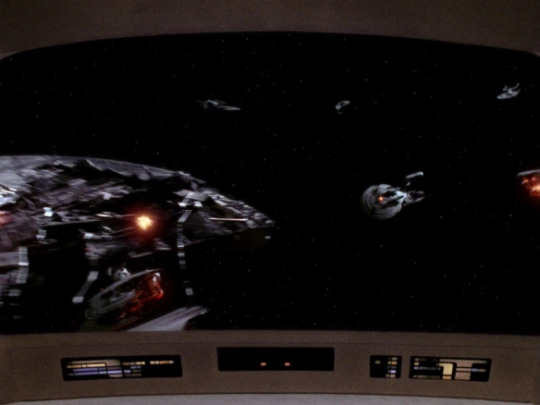
Somewhere out there, Benjamin Sisko is incredibly pissed off at how his character arc has started.
More than forty ships, thousands of Starfleet personnel, destroyed in a matter of minutes by a single Borg cube. It gets even worse when we learn that one of these ships is the USS Melbourne, the very ship which Riker had been offered.
Riker seems to recover from the news pretty quickly (though it's more likely that he's just as horrified and hiding it for the sake of the crew) and orders them to move to intercept the Borg using Shelby's original plan of separating the Enterprise's saucer section. Picard may be expecting that (remember how Shelby had briefed him on it?) but Riker is counting on it.
Both halves of the ship fail to do any damage and evade any of the Borg's attacks. But that's not the point of the attack.
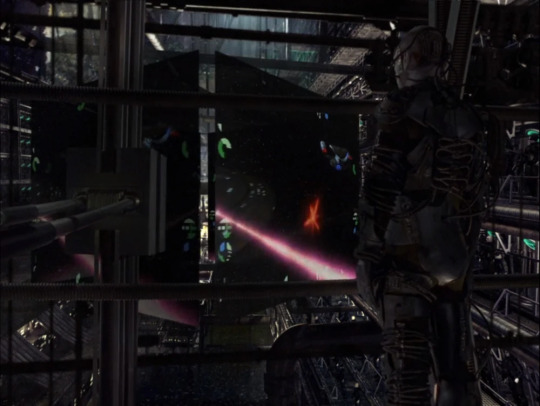
Riker had anticipated Locutus' reactions ahead of time. Earlier, he took Data and Worf aside to brief them on a special assignment. While the Borg are distracted by the two Enterprise sections, they fly a shuttle through the cube's electromagnetic field, allowing them to beam aboard and recover Locutus.

Don't you just love a happy reunion?
The saucer section may have been crippled, but with the threat seemingly being neutralised, the Borg continues on course to Earth, apparently being 100% fine that their incredibly high-value prisoner who was meant to act as the liaison between them and humanity has just been recaptured.
"You underestimate us if you believe this abduction is any concern."
Okay... I mean, I guess he wasn't exactly essential to the invasion.

"Oh shit... how much did I have to drink last night?"
Locutus says that he will do them no harm, and will continue to speak for the Borg as they continue on their course towards Earth.
And everyone is apparently okay with this? Having a Borg drone on board feels like a recipe for either disaster or wacky comedic hijinks. And they do deactivate him, but not before he gets a chance to talk shit about how he'll assimilate all of the crew.
They'd previously discovered that a series of subspace signals have been emanating between Locutus and the Borg cube, and theorise that these signals form the basis of the Borg's collective consciousness. Way back in Q Who, they witnessed that the Borg would self-destruct when separated from the hive mind, which would kill Picard, so their plan is to have Data connect his brain to Locutus' while Dr Crusher performs microsurgery to restore Picard's humanity.
Finally, some treknobabble that actually makes sense to me. Only took us four seasons.
Just as Data gains access to the Borg's neural net, Locutus realises what they're doing and tries to stop them. Data responds by removing Locutus' deely-bopper hand thing which all the Borg have for some reason, so now he just looks like he has his arm stuck in a high-tech Pringles tube.
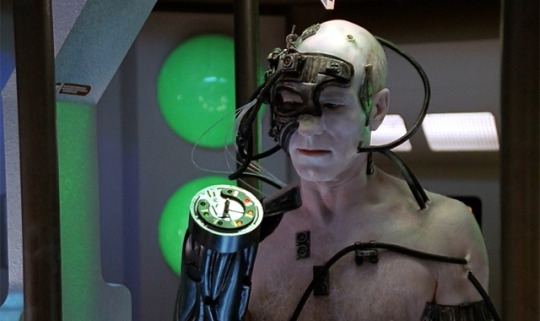
They realise that the Borg are unable to sever their link to Picard, so Data attempts to implant a command in the Borg's consciousness to disarm their weapons.
Think of it like that Robot Chicken night crew sketch where getting one Borg to party convinced them all to party, except we're supposed to take this completely seriously.

I'll be honest, I was hoping for an ending that was a bit less... anticlimactic.
To the credit of Michael Piller (who wrote both parts), he probably realised this and tried to ramp up the tension by having Riker almost resort to setting the Enterprise on a collision course with the Borg cube, as well as the uncertainty of what will happen to Picard, but of course the Borg are disabled, the cube is destroyed, and Picard is returned to normal.
Riker: How much do you remember?
Picard: ...Everything. Including some brilliant strategy from a former First Officer of mine.
Hoo boy.
Even later, when Picard's implants have been removed, Shelby disembarks and Riker reaffirms his confidence in his own career path, we get the sense that he still hasn't entirely recovered.
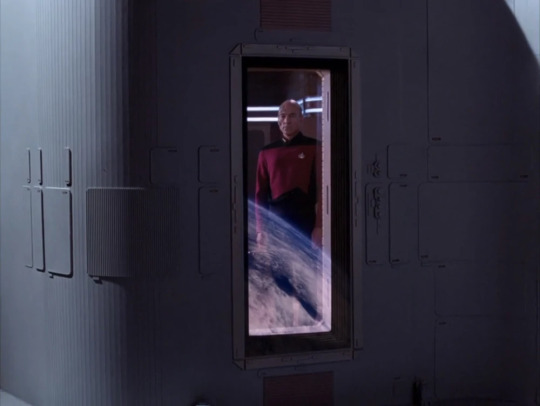
Looks like someone's going to need some
Shore Leave Therapy!
7.5/10 - Not quite as strong as the first part, but still a worthy conclusion.
There. It's over. Now onto the rest of the season.
Previous Episode | TNG Masterpost | Next Episode
#star trek#star trek the next generation#star trek tng#star trek review#captain picard#jean luc picard#uss enterprise#will riker#captain riker#geordi la forge#deanna troi#star trek guinan#beverly crusher#wesley crusher#miles o'brien#star trek worf#star trek data#the borg#borg cube#locutus#season premiere#season 4
5 notes
·
View notes
Text
Star Trek Villains Who Actually Had a Point
https://ift.tt/3t8D3MQ
This article contains spoilers for various parts of the Star Trek franchise.
Last fall, airing just a few weeks apart, both Star Trek and Star Wars debuted season premieres of new streaming TV episodes in which the heroes of each show had to fight a giant, legless worm-monster. In Star Trek: Discovery’s “That Hope Is You Part 1,” it was the deadly Tranceworm, while The Mandalorian’s “Chapter 9: The Marshall” had the murderous Krayt Dragon. The differences between the Final Frontier and the Faraway Galaxy could not have been made clearer by these dueling beasts: in Mando, the plot involved killing the monster by blowing up its guts from the inside, while in Disco, Book taught Michael Burnham how to make friends with it.
The Trek universe deals with the concept of evil a little differently than many of its famous genre competitors. There is no Lex Luthor of the Federation. Palpatine doesn’t haunt the planet Vulcan. The Klingons have no concept of “the devil.” (At least in The Original Series.) This isn’t to say Trek doesn’t have some very memorable Big Bads, it’s just that most of the time those villains tend to have some kind of sympathetic backstory. Even in the J.J. Abrams films!
So, with that in mind, here’s a look at seven Star Trek villains who maybe weren’t all bad, and kind of, even in a twisted way, had a point…
Harry Mudd
In Star Trek: The Original Series, Harry Mudd was presented as a straight-up con-man, a dude who seemed to be okay with profiting from prostitution (in “Mudd’s Women”) and was also down with marooning the entire crew of the Enterprise on a random planet (in “I, Mudd”). He’s not a good person. Not even close. But, he does make a pretty could case against Starfleet’s lack of planning. In the Discovery episode “Choose Your Pain,” Mudd accuses Starfleet of starting the war with the Klingons, and, as a result, putting the larger population of the galaxy at risk. “I sure as hell understand why the Klingons pushed back,” Mudd tells Ash Tyler. “Starfleet arrogance. Have you ever bothered to look out of your spaceships down at the little guys below? If you had, you’d realize that there’s a lot more of us down there than there are you up here, and we’re sick and tired of getting caught in your crossfire.”
Seska
At a glance, Seska seems pretty irredeemable. She joins the idealistic Maquis but is secretly a Cardassian spy. Once in the Delta Quadrant, she tries to screw Voyager as much as possible, mostly by hooking up with the Kazon. That said, Seska is also someone caught up in hopelessly sexist, male-dominated power structures and does what she has to do to gain freedom and power. The Cardassian military isn’t exactly enlightened nor kind, so the fact that Seska was recruited into the Obsidian Order in the first place certainly explains her deceptive conditioning. You could argue that Seska could have become a better person once she had Captain Janeway as an ally, but, the truth is, she was still a spy caught behind enemy lines, but suddenly without a government to report back to. So, Seska did what she had to do to survive, even lying to Chakotay about having his child. The thing is, again, outside of Starfleet, Seska is at the mercy of the sexist machinations of the Kazon, so again, she’s kind of using all the tools at her disposal to gain freedom. Had Voyager not gone to the Delta Quadrant, and Seska’s villainy may have been more clear-cut. But, once the reason for her espionage becomes moot, her situation gets more desperate, and, on some level, more understandable.
Charlie Evans
In The Original Series, Kirk loves telling humans with god-like powers where to shove it. In “Where No Man Has Gone Before,” he phasers Gary Mitchell and buries him under a rock. But, in “Charlie X,” when teenager Charlie Evans also gets psionic powers, Kirk does a less-than-a-great job of being a good role model. For most of the episode, Kirk tries to avoid become Charlies’ surrogate parent, and when he does try, it results in an embarrassing overly macho wrestling match featuring those famous pink tights.
Read more
TV
How Star Trek: The Next Generation’s Killing of Tasha Yar Became an Awkward Mistake
By Joseph Baxter
TV
Why Star Trek Needs More Characters Like Captain Lorca
By Lacy Baugher
Charlie was a deeply troubled human being, and there was no justification for him harassing the crew and Janice Rand in specific. But, angry, kids like Charlie have to be helped before it gets to this point. Kirk mostly tried to dodge the adult responsibility of teaching Charlie the ropes, and only when some friendly aliens arrived, did everyone breathe a sigh of relief. But, don’t get it twisted, those aliens are basically just social workers, doing the hard work Starfleet is incapable of.
The Borg Queen
Because the origin of the Borg Queen has dubious canonical origins, all we were told in Voyager is that she was assimilated as a child, just like Seven of Nine. As Hugh and Jean-Luc discuss in the Picard episode “The Impossible Box,” basically, everyone assimilated by the Borg, is, on some level, a victim. The Queen was never presented this way in either First Contact or Voyager, but, at one point, writers Judith and Garfield Reeves-Stevens had pitched a story for Enterprise which would have featured Alice Krige as a Starfleet medical technician who made contact with the Borg.
Because both Alice Krige and Susanna Thompson played the Borg Queen, it’s possible the backstories of each Queen is different and that maybe they aren’t the same character. Either way, assuming the Borg Queen retains some level of autonomy relative to other drones (likely?) then she’s pretty much making the best of a bad situation. In fact, at the point at which you concede the Borg are unstoppable, the Queen’s desire to let Picard retain some degree of his independence as Locutus could scan as a kind of mercy. The Borg Queen actually thinks she and the Borg are making things simpler for everyone. And with both Data and Picard, she tried to make that transition easier and, in her own perverse way, fun too.
Ossyra
Yes, we saw Ossyra feed her nephew to a Trance worm, and we also saw her try to kill literally everyone on the USS Discovery, including Michael Burnham. However, in the middle of all of that, Ossyra did try to actively make peace between the Emerald Chain and the Federation. And, most tellingly, it was her idea. Ossyra also pointed out one of the most hypocritical things about the United Federation of Planets: the fact that Starfleet and its government rely on capitalism without actively acknowledging it. Essentially, Ossyra was saying that the ideals of the Federation are great, but the Federation has all kinds of dirty little secrets it doesn’t want to talk about. In her meeting with Admiral Vance, pretty much everything she said about the Federation was true—and her treaty proposal was fair.
Read more
TV
Q’s Return on Star Trek: Picard Season 2 will Follow “Significant Trauma”
By Joseph Baxter
TV
Why Star Trek: Discovery Needed to Write Out Its Klingons
By Lacy Baugher
The only snag: she wouldn’t turn herself over as a war criminal. Considering the fact that the Federation made Mirror Georgiou into a Section 31 agent, despite her war crimes in another universe, this also seems hypocritical. Why not just do the same thing with Ossyra? Tell everyone she’s going to prison for war crimes, but make her a Section 31 agent instead? Missed opportunity!
Khan
Khan was genetically engineered by wacko-a-doodle scientists at the end of the 21st Century. At some point on Earth, he became a “prince” with “power over millions.” But, as Kirk notes in “Space Seed,” there were “no massacres” under Khan’s rule, and described him as the “best of the tyrants.” Kirk’s take on Khan in “Space Seed” is basically that Khan was an ethical megalomaniac. Most of what we see in “Space Seed” backs this up. Khan doesn’t actually want to kill the crew, and stops short of doing it when he thinks he can coerce them instead. His only focus is to gain freedom for himself and his exiled fellow-Augments. In the Kelvin Universe timeline, Khan’s motivations are similar. Into Darkness shows us a version of Khan who, again, is only cooperating with Section 31 because he wants freedom for his people. Sure, he’ll crush some skulls and crash some starships to get to that point, but in his dueling origin stories, Khan is, in both cases interested in freedom for his people, who, are by any definition, totally persecuted by the Federation.
Khan is still a criminal in any century. But, we only really think of him as a villain because he goes insane in between the “Space Seed” and The Wrath of Khan. The Khan of The Wrath is not the same person we met in “Space Seed.” As he tells Chekov, “Admiral Kirk never bothered to check on our progress.” Had Kirk sent a Starfleet ship to drop in on Khan and his “family” every once in awhile this whole thing could have been avoided. In the prime timeline, Khan goes nuts because Ceti Alpha VI explodes and nobody cares. In the Kelvin timeline, Admiral Marcus blackmails him. Considering that Khan is Star Trek’s most famous villain, it’s fascinating that there are a million different ways you can imagine him never getting as bad as he became. In “Space Seed,” he and Kirk basically part as friends.
Q
In “Encounter at Farpoint,” Q accuses humanity of being “a savage child race.” And walks Jean-Luc Picard through the various atrocities committed by humanity, through the 21st Century. Picard kind of shrugs his shoulders and says, “we are what we are and we’re doing the best that we can.” When we talk about the philosophy of Star Trek, we tend to give more weight to Picard’s argument: the idea that by the 24th century, humanity has become much better, in general than it is now. But, the other side of the argument; that there’s a history of unspeakable violence and cruelty baked into the existence of humanity, is given less weight. We don’t really listen to Q when he’s putting humanity on trial, because we can’t see his point of view.
cnx.cmd.push(function() { cnx({ playerId: "106e33c0-3911-473c-b599-b1426db57530", }).render("0270c398a82f44f49c23c16122516796"); });
But, because Q wasn’t a one-off character, and because he said “the trial never ends” in the TNG finale, he’s actually not really a villain at all. Q exists post-morality, as we can imagine it. His notions of ethics are far more complex (or less complex) than we can perceive. Q is one of those great Star Trek characters who is actually beyond reproach simply because we have no frame of reference for his experiences or point of view. In Voyager, we also learned that even among other members of the Q Continuum, Q was kinder, with a more humanitarian approach to what he might call “lesser” lifeforms. If Q is villainous, it’s because of our definitions of villainy. Of every Star Trek antagonist, Q is the best one, for the simple fact that he’s not a a villain at all.
Which Star Trek villains do you think had a point? Let us know in the comments below.
The post Star Trek Villains Who Actually Had a Point appeared first on Den of Geek.
from Den of Geek https://ift.tt/3eIGmoq
6 notes
·
View notes
Text
TNG: “The Best of Both Worlds, Part II”

Commander Riker didn’t want to accept a promotion that would take him away from the Enterprise, but now he’s the captain of the Enterprise. Lt. Commander Shelby resented Riker for being in the way of her career advancement, but now she’s his first officer. Captain Picard didn’t want to help the Borg invade the Federation, but now he is Locutus of Borg and his strategic knowledge is helping them cut through Earth’s defenses. ...Wait, that last one is bad.
At long last, we’ve finally reached the point where I started watching Star Trek: The Next Generation regularly, as a fan, and not just because my parents had the remote control. I hadn’t even heard of the Borg, let alone the shocking cliffhanger of the third season finale. I just overheard my parents talking about how “the captain got turned into a Borg” and thought that was weird. We were having dinner while this episode premiered, so by the time we finished eating I was sucked in to the story’s problem: How do you stop invincible cyborgs that stole your greatest leader? Riker’s approach to solving the problem is probably what made me a bigger Trek fan than my parents.
This is, incidentally, the first time the Borg speak of assimilation, both to describe what they’ve done to Picard and what they wish to do to the Federation’s culture and technology. In “Q Who” they just wanted to field-strip cities to consume the technology, and in “The Best of Both Worlds” they talk of making the Federation culture “service us.” Turning Picard into a Borg seemed to be an unusual tactic to achieve those goals. Now, though, turning everyone into Borg is the goal; the writers seem to have realized that it’s the most insidious and captivating thing about this enemy, and have suddenly made it their raison d'etre. So now they consume technologies and subjugate cultures by absorbing them.
I’m not sure I can express what a powerful symbol the Borg became for an unstoppable, uncaring threat. Internet memes have likened politicians and corporations to the Borg since before they were called memes. The utter impotence of the Enterprise’s hot new weapon, and the righteousness of Riker’s lost cause, and the sense that it’s just not fair, probably have more to do with those memes than the whole techno-zombie aesthetic. Nowadays, pop culture is spoiled for choice for instantly recognizable metaphors for absurdly overpowered opponents, from Sailor Moon to, uh, Shaggy for some reason. But back in the day we mainly had “resistance is futile.”
To appreciate Riker’s winning strategy, I think it’s important to understand that Locutus’s dialogue is very much Borg objectives wrapped in Picard’s diplomacy. They didn’t just get him to learn how to crush Starfleet armadas; they want him to persuade his countrymen to surrender. If not for Locutus I’m not sure the Borg would even bother parleying with Riker. It’s certainly the Picard in Locutus that makes him (incorrectly) surmise Riker’s ulterior motive, and then assume Riker wanted to capture him out of misguided sentiment. The Borg assimilated Picard’s raw knowledge about Riker (he’s sneaky and he likes me) but make no use of Picard’s wisdom to figure out what Riker’s really up to. This delays the Borg from realizing they can’t let Riker have Locutus until it’s too late.
In the end, of course, we get Picard back, and Shelby takes an assignment rebuilding the Federation fleet. This leaves Captain Riker to decide whether to take his new promotion to another ship, or resume serving as Picard’s first officer. I respect Riker’s decision to stick around (apparently busting him back down to commander), but I don’t entirely understand why Starfleet does. It was clear in Part I that the top brass were annoyed that he wouldn’t accept a promotion to captain, and in this episode he finally does, so why would they immediately let him call backsies?
4 notes
·
View notes
Text
Star Trek Has More Wars Than Star Wars: Here Are The Greatest

Here are the greatest wars of Star Trek, which has actually had more wars across its franchise than Star Wars. At its core, Star Trek is about an optimistic future of space exploration and the harmonious co-existence of multiple worlds as embodied by the United Federation of Planets. And yet, Star Trek's history is full of conflict; indeed, after The Original Series in the 1960s, every Star Trek TV series has been embroiled in some form of war.
Predating Star Wars' creation by a decade, Star Trek's central tenet is about seeking out new worlds and new civilizations. But even though Captain Kirk (William Shatner) and the Starship Enterprise of the 23rd-century dealt with all manner of hostile alien lifeforms, actual full-blown wars weren't something depicted until Star Trek: The Next Generation's 24th-century era. By contrast, George Lucas' creation was titled Star Wars but the films really only dealt with three wars: The Clone Wars of the prequels, the conflict between the Empire and the Rebellion in the original trilogy, and the First Order vs. the Resistance in the sequel trilogy. Meanwhile, the five Star Trek spinoff TV series have involved several wars across the various eras of the Federation.
Next: After 13 Years Of Rights Issues, Star Trek Is Whole Again
Indeed, the history of Star Trek was forged through wars: the Eugenics Wars of the 1990s gave rise to the villainous Khan and World War III in the 21st-century devastated humanity before First Contact with the Vulcans opened the door to the establishment of Starfleet. The United Federation of Planets was then founded in 2161, which Star Trek: Enterprise's Captain Jonathan Archer (Scott Bakula) presided over. But prior to the Federation's formation, the Earth-Romulan War of 2156-2160 led to the creation of the Romulan Neutral Zone and Star Trek: Discovery's Klingon War of 2257 was an outbreak of open hostilities in the middle of a Cold War that lasted over 70 years, which finally ended when the Klingons sued for peace in 2293, as seen in Star Trek VI: The Undiscovered Country.
While the Star Trek movies set in the Prime and Kelvin timelines had their share of violent conflicts, the greatest wars of Star Trek were depicted across the various TV series from Star Trek: The Next Generation to Star Trek: Discovery. Here are the epic Star Trek wars that cumulatively outnumber those of Star Wars.
The Xindi War on Star Trek: Enterprise

Star Trek: Enterprise season 3 saw the crew of the NX-01 Enterprise caught up in a year-long war with the Xindi, which was just part of a larger Temporal Cold War fought across the timestream by different factions. In the Star Trek: Enterprise season 2 finale, the Xindi attacked Earth with a superweapon, which devastated a swath of Earth from Florida to Venezuela and killed seven million people.
Captain Archer led an upgraded Enterprise into the Delphic Expanse to stop the Xindi from launching a second attack; during the course of the war, Archer learned the Xindi were pawns of another race called the Sphere-Builders, who were capable of seeing alternate timelines. The Sphere-Builders were trying to destroy Earth in the 22nd century, fearing a future where the Federation would destroy the Sphere-Builders in the 26th century. Eventually, Archer made peace with the Xindi and convinced them that they were being manipulated by the Sphere-Builders; the Enterprise crew destroyed the Xindi primary weapon before it could attack Earth again and they destroyed the Spheres, banishing the Builders back to their native trans-dimensional realm.
Related: Star Trek's Crazy (& Brilliant) Reason Why So Many Aliens Look Human
The Borg Vs. Species 8472 on Star Trek: Voyager

In 2374, as the U.S.S. Voyager entered Borg space in the Delta Quadrant, they were caught in the middle of the war between the Borg and Species 8472. The two deadly races battled for over 5 months, with the Borg suffering heavy casualties as they encountered the first alien species they could not easily assimilate or defeat. Species 8472 was a highly-advanced biological race that existed in fluidic space. When the Borg discovered a way to access fluidic space, they tried and failed to conquer Species 8472, who then went on the offensive and invaded the Milky Way galaxy. One bio-ship from Species 8472 could destroy 15 Borg Cubes and in one encounter, Species 8472 destroyed 8 Borg planets, 312 ships, and killed 4,000,621 drones.
Fearing this new threat, Captain Kathryn Janeway (Kate Mulgrew) partnered with the Borg, which brought Seven of Nine (Jeri Ryan) aboard the U.S.S. Voyager. The Starfleet/Borg alliance developed a biological weapon that forced Species 8472 back to fluidic space, ending the war. Later, Species 8472 determined that humanity was a greater threat than the Borg and created simulations in order to defeat the Federation and human beings. However, Janeway brokered peace with Species 8472, convincing them that the Federation had no designs on invading fluidic space.
The War Against Control on Star Trek: Discovery Season 2

In Star Trek: Discovery season 2, Control, Section 31's threat assessment system, attempted to gain sentience and wipe out all biological life in the galaxy - a goal Control achieved by the 32nd century according to the time-traveling Red Angel, who was revealed to be Dr. Gabrielle Burnham (Sonja Sohn). Much of Star Trek: Discovery season 2 centered on the U.S.S. Discovery's pursuit of the secret of the red signals in space, which ended up providing the means to stop Control. This included freeing Kaminar, the Kelpien homeworld, from dominion by the Ba'ul and Captain Christopher Pike (Anson Mount) acquiring a Klingon time crystal.
It all culminated in the final battle against Control in Star Trek: Discovery's season 2 finale, "Such Sweet Sorrow", where the U.S.S. Discovery and the U.S.S. Enterprise were joined by the Kelpiens and the Klingons to battle Section 31's drone fleet. The climactic battle was the most eye-popping and violent space battle ever depicted in a Star Trek TV series and it ended with the destruction of Control as Michael Burnham (Sonequa Martin-Green) assumed the identity of the Red Angel and led the Starship Discovery into the 32nd century to prevent Control from ever gaining sentience.
Related: Where Was The Enterprise During Star Trek: Discovery's Klingon War?
Star Trek: Discovery Season 1's Klingon War

The Klingon War against the Federation of 2256-2257 spanned the entirety of Star Trek: Discovery season 1. The war was started by Commander Michael Burnham at the Battle at the Binary Stars, which left her disgraced and imprisoned as Starfleet's first mutineer. Meanwhile, the Klingon Messiah T'Kuvma (Chris Obi) tried to unite all of the Great Houses under his leadership but after Burnham killed him, the warrior race splintered off into opposing factions while continuing the war against the Federation.
The Federation suffered devastating losses during the Klingon War: over 8,000 Starfleet personnel died in the first 6 months of the conflict. Nine months later, twenty percent of Federation space was occupied by the Klingons, including Starfleet's Starbase 1, which saw 80,000 lives lost. When the U.S.S. Discovery returned from its diversion into the Mirror Universe, the Terran Emperor Phillipa Georgiou, posing as her counterpart Captain Philippa Georgiou, attempted to commit genocide on the Klingon homeworld in a bid to end the war before the Klingons could invade Earth. In response, Michael Burnham allied with L'Rell (Mary Elizabeth Chieffo) to stop Georgiou's plan; they installed L'Rell as the new Klingon High Chancellor and ended the war.
The Federation Vs. The Borg on Star Trek: The Next Generation

The Federation's conflict with the Borg was mostly fought in Star Trek: The Next Generation and the subsequent feature film Star Trek: First Contact. In the classic two-part episode "The Best of Both Worlds", the Borg Collective mounted their invasion of the Federation, assimilating Captain Jean-Luc Picard (Patrick Stewart) and turning him into Locutus of Borg. It culminated in the Battle of Wolf 359, one of the most destructive engagements of the 24th century: 39 Starfleet ships were lost against one Borg Cube, with over 11,000 people either killed or assimilated. Though the U.S.S. Enterprise-D rescued Picard and destroyed the Borg Cube, it wouldn't be their last encounter with the Borg.
The Battle of Wolf 359 had lasting repercussions: the Defiant-class starships were developed to fight the Borg and Commander Benjamin Sisko (Avery Brooks) lost his wife Jennifer in the conflict. The Borg later attempted to time travel and assimilate 22nd century Earth in Star Trek: First Contact but Picard and his crew foiled them again. However, the Federation never completely defeated the Borg, who will return in Star Trek: Picard, although a faction of the Borg Collective has seemingly been conquered by the Romulans. Still, the Borg remain a hostile threat to the Federation any time they emerge from their home base in the Delta Quadrant.
Related: Star Trek: Picard Theory: The Borg Doomed Romulus
The Dominion War on Star Trek: Deep Space Nine

The Dominion War in Star Trek: Deep Space Nine is the greatest war ever fought in Star Trek. At its peak, the conflict involved every major power in the Alpha Quadrant siding with two opposing factions: the Federation, Klingons, and Romulans vs. the Dominion, Cardassian, and Breen alliance. While the formal hostilities lasted from 2373-2375, the Dominion instigated a Federation-Klingon War, destroyed the Cardassian Obsidian Order and the Romulan Tal'Shiar, and successfully executed a coup on Cardassia prior to the Dominion War, which weakened the Alpha Quadrant before the Changelings and the Jem'Hadar mounted their full-scale invasion from the Gamma Quadrant.
The devastation caused by the Dominion War was staggering: thousands of starships and millions of lives were lost on both sides, with Cardassia suffering the most as the Dominion systematically eliminated the Cardassian population, killing 800 million civilians in the waning days of the war. The Dominion also conquered Betazed, homeworld of Counselor Deanna Troi (Marina Sirtis), and the Breen attacked Starfleet Headquarters on Earth. Captain Sisko tricking the Romulans to fight on the Federation's side turned the tide of the war, while Section 31's use of a biogenic virus by secretly causing Odo to infect the Founders accelerated the Federation's ultimate victory. Sisko led the invasion of Cardassia that resulted in the signing of the Treaty of Bajor on Deep Space Nine, formally ending the war and forcing the Dominion to permanently retreat into the Gamma Quadrant.
The Dominion War altered the balance of power in the Alpha Quadrant; the Klingons incurred such loses that it would take them a decade to recover and the Cardassian Union completely collapsed, which left the Federation and Romulans as the strongest powers in the Quadrant - until Shinzon's coup wiped out the Romulan Senate in Star Trek: Nemesis. Thanks to the serialized format of Star Trek: Deep Space Nine, which boasted 26 episodes per season, the series was able to depict the myriad complexities of the Dominion War from the military, political, and characters' perspectives. All in all, Star Trek fans may not see a war as epic and far-reaching as the Dominion War again.
Next: Everything Star Trek: Picard Is A Sequel To
source https://screenrant.com/star-trek-wars-greatest-borg-dominion-klingons/
1 note
·
View note
Text
Battle of Star Trek - Batch#8 Quarter-Finals (featuring Picard, Trip, Kira & Georgiou)
We edge closer to discovering your favourite character from across all the series and movies. 128 characters slowly being whittled down to 1 eventual winner.
Here we are in the 8th and final batch, the quarter-finals no less! We have 8 characters ready for you to vote them to 'champ' status, where they will then take on other champs.
Have a look at who's still in the competition and then head over to twitter - add procrastinalien - and then get voting.
DEANNA TROI

Counselor Troi was half Betazoid and half Human. She was empathic and so valuable to Captain Picard she had a permanent seat on the bridge. She held the rank of Lt. Commander through most of the series, before desiring more responsibility and becoming promoted to Commander. As well as her duties, her duties she had a number of romantic storylines - most notable with Will Riker, who she ended up marrying. Marina Sirtis played Troi throughout all seven seasons of STAR TREK: THE NEXT GENERATIONS, all four movies that followed, returning for some guest spots in VOYAGER - advising Lt. Barclay as he helped guide the crew home.
DATA

Lt. Commander Data was an android created by Noonien Soong. He applied to Starfleet and served aboard USS Enterprise-D (and E) under Captain Picard as the Operations Manager (the science officer and second officer). He studied humanity and desiring to become human - or as close as he could to it. He installed an emotion chip, but Data's relationship with his emotions were complicated. He formed many friendships, most importantly Geordi, his best friend. Despite being 'immortal', it's Data who sacrificed himself in NEMESIS, and effectively died. Although the presence of his 'brother' B4 suggests the essence of Data may have lived on. Brent Spiner played Data throughout all seven seasons of THE NEXT GENERATION and their four movies.
JEAN-LUC PICARD

One of the most iconic characters in all of Trek, Captain Jean-Luc Picard commanded the USS Enterprise-D (and E) the flagship for Starfleet. This meant he served many important missions - including first contact with the impish Q, which in turn lead to first contact with the dreaded Borg. When the Borg attacked Earth they assimilated him into the hybrid Locutus. This is an event that would stay with him for years after. On the pluss side, He got to serve alongside Ambassador Spock, and even met, and fought alongside, the famous Captain Kirk. Patrick Stewart played Picard for all seven seasons of TNG, plus the four movies. He also got to give Commander Sisko his orders in the pilot for DEEP SPACE NINE.
CHARLES 'TRIP' TUCKER III

'Trip' was the chief engineer aboard the NX- Enterprise in the 22nd Century. He was good friends with his commanding officer, Captain Archer, and despite his distrust of the Vulcans, formed a romantic relationship with T'Pol after she entered the infamous Pon Far. Tucker was often seen to be hot headed, but was still the second officer on the ship. Connor Trinneer played Trip for all four seasons of STAR TREK: ENTERPRISE.
KIRA NERYS

Major Kira was once a remember of the Bajoran resistance during the Cardassian occupation on her home world, Bajor. She serves as the first officer on the space station Deep Space Nine, but is initially unsure o f(and even aggressive towards) Starfleet's presence - possibly seeming them as a new oppressor. What blurs the lines is when commanding officer Benjamin Sisko becomes the Emissary - a religious icon for her people. Eventually she learns to respect the Federation and forms many friends on the station. She, herself, ends up promoted to Colonel during the war with the Dominion. On a personal level, she becomes romantically involved with station security officer 'Chief' Odo. Nana Visitor played Kira during all seven seasons of STAR TREK: DEEP SPACE NINE.
JANICE RAND

Captain Kirk's yeoman Janice Rand served aboard the famous USS Enterprise. She was only seen a few times - including a point when she became the object of affection by 'Charlie X'. She was later seen (mostly in the back ground) rising up through the ranks in movies and later served on the USS Excelsior under Captain Sulu, where she'd achieved the position of communications officer and rank of Lieutenant (junior grade). Grace Lee Whitney played Janice Rand during the first season of STAR TREK: THE ORIGINAL SERIES, a couple of the films with the same cast, and then a guest appearance on VOYAGER.
SYLVIA TILLY

Cadet Tilly talks a lot when she's nervous... and she's pretty nervous when she finds out that her new room mate is none other than the notorious mutineer Michael Burnham. Despite her reservations, the pair hit it off and become firm friends. The nervy cadet is assigned to engineering under Lt. Stamets, as they work on the experimental Spore drive aboard the USS Discovery. When the ship finds itself in the Mirror Universe, Tilly has to pretend to be her Mirror counterpart - who just happens to be the commanding officer! When the ship gets back, and helps to diffuse the war with the Klingons, Tilly is promoted to Ensign and put on the command track, where she'll start her journey to her own command (for real!). Mary Wiseman played Tilly for the first season of STAR TREK: DISCOVERY, and will return for the second.
PHILIPPA GEORGIOU

Captain Georgiou was the commanding officer of the USS Shenzhou. Her ship ended up making contact with some Klingon extremists. In an intense situation, she found her first officer (Commander Burnham) mutinying against her... the situation worsens... resulting the a war with the Klingons, and the death of Georgiou. When The USS Discovery find themselves in the Mirror Universe, they discover that the ruling Emperor is none other that Georgiou. When the ship finds a way to get back to their own universe, Burnham - feeling guilt - brings Emperor with them. Back in the Prime universe, Mirror Georgiou pretended to be Captain Georgiou - to confuse the Klingons (and everyone else). Once her role is played out, she slinks into the shadows. Georgiou was played by Michelle Yeoh, appearing as a 'special guest star' in the first seasons of STAR TREK: DISCOVERY. She's expected to return at some point, maybe in season two,
So there you have it people. Those are your eight options... now lets get them down to four for the semi-finals shall we? You've got three days to vote over on twitter - so get voting!
#star trek#star trek the next generation#deanna troi#marina sirtis#data#brent spiner#jean-luc picard#Patrick Stewart#star trek enterprise#connor trinneer#charles tucker iii#trip#star trek deep space nine#kira nerys#nana visitor#star trek the original series#Janice Rand#grace lee whitney#Star Trek Discovery#sylvia tilly#mary wiseman#Philippa Georgiou#michelle yeoh#Twitter#star trek voyager
5 notes
·
View notes
Text
Episode Reviews - Star Trek: The Next Generation Season 4 (1 of 6)
Ok, I’ve been procrastinating on this for a while, so without further ado, let’s renew our look into episodes of Star Trek: The Next Generation by warping into the start of the show’s fourth season, beginning with the conclusion to the ground-breaking two-part story “The Best of Both Worlds”.
Episode 1: The Best of Both Worlds (Part 2)
Plot (as adapted from Wikipedia):
The discharge fired from the Enterprise’s deflector dish has no effect on the Borg cube; Locutus reveals that the Borg had prepared for the attack using Captain Picard's knowledge. The Borg cube continues at warp speed towards Earth, with the crippled Enterprise unable to follow. Upon reporting their failure to Admiral Hanson, Commander Riker is promoted to Captain and makes Commander Shelby his first officer. The crew learns that a fleet of starships is massing at Wolf 359 to stop the Borg. Guinan suggests to Riker that he "let go of Picard", since Picard's knowledge is being used to thwart Starfleet tactics, in order to defeat the Borg and possibly save Picard's life.
The Enterprise arrives at Wolf 359 to find that Hanson has been killed and the fleet destroyed, including the starship Riker had been offered command of in Part 1. The Enterprise then follows the cube's warp trail to an intercept point and offers to negotiate with Locutus. The request is denied, but the communication reveals Locutus's location within the cube. The Enterprise then separates into saucer and stardrive sections. Although Shelby suggested attacking with the stardrive section, Riker does the reverse and orders the saucer section to fire an antimatter spread near the cube, disrupting its sensors and allowing a shuttlecraft piloted by Lt. Commander Data and Lt. Worf to pass the Borg shields and beam aboard the Borg cube. They kidnap Locutus, although the Borg ignore this and continue to Earth.
Data and Dr Crusher create a neural link with Locutus to gain access to the Borg's collective consciousness. Data attempts to use the link to disable the Borg's weapons and defensive systems, but cannot, as they are protected by security protocols. Picard breaks free from Borg control and mutters, "sleep". Dr Crusher comments that Picard must be exhausted from this ordeal, however Data deduces that Picard is suggesting accessing the Borg regeneration subroutines, which are less protected than key systems like weapons or power. Data issues a command to the Borg to enter sleep mode, causing their weapons and shields to deactivate. A feedback loop builds in the Borg cube, which destroys the vessel. Dr Crusher and Data remove the Borg implants and augmentations from Picard.
The Enterprise is awaiting repairs at an orbital shipyard, and Riker, although offered command of his own ship, insists on remaining as first officer. Shelby is reassigned to a task force dedicated to rebuilding the fleet. Picard physically recovers, but is still psychologically disturbed by his ordeal.
Review:
While Part 1 was great for the first season-bridging two-part cliff-hanger of TNG and of wider Trek lore ever to be done, the second part comes to drop the ball a little on delivering follow-through to part 1’s set-up. Granted, we still get some decent character performances and a good plot with what little decent action the episode could afford, but it’s ultimately failing to deliver on the level of action that is at times promised. Anyone coming into this from watching some later Trek productions like DS9’s story lines with fighting first the Klingons and then the Cardassian-Dominion alliance will see just how much this episode falls short on the action front; indeed, it’s not until DS9’s pilot episode that we get to see the infamous Battle of Wolf 359 in any real detail, as opposed to a DS9 episode like ‘Sacrifice of Angels’ which is almost wall-to-wall starship action at times.
The solution also seems to come too quickly and is almost too convenient. Part of this is because the first part was written without a solution ‘waiting in the wings’. If Memory Alpha is to be believe, Michael Piller waited until he knew he would be staying on as TNG’s story editor before trying to write his way out the seemingly impossible-to-escape cliff-hanger he’d created in part 1. Now while I can understand that desire not to tie yourself into a solution to something that might not be your problem, I think in any kind of continual story-telling, early parts should always be written to leave a few options open. Even if you’re not writing the solution because you’re doing a form of writing like TV or film where you’re not guaranteed to write the next instalment, I think it’s just good manners to fellow writers and to your audience not to write a hard-to-solve cliff-hanger.
As it is, I can’t help feeling TNG might have benefited from extending part 2 a bit more and potentially turning this into a trilogy, much as DS9 did with its season 2 opening episodes. Still, I suppose it ends well enough, and I’m glad this episode and later ones gave us a sense that Picard remains affected by his assimilation experience. Not only is this ground-work that later ex-Borg characters like Voyager’s Seven of Nine would rely on simply to exist, but it’s another move by the show away from being just an unending array of one-off adventures with little to no consequences for anyone involved. That kind of overly simplistic and unrealistic story-telling just isn’t Trek-worthy, and I’m glad it was starting to die out here. Overall score for this episode, 8 out of 10.
Episode 2: Family
Plot (as adapted from Wikipedia):
The Enterprise is docked at Earth Station McKinley, undergoing repairs and refitting following its battle with the Borg. The episode follows the interactions of three members of the crew with their family members. Lt. Worf's adoptive human parents, Sergey and Helena Rozhenko visit the Enterprise, having learned about his discommendation some time ago, but also having been unable to support him as they would wish due to being lightyears apart. Worf, though embarrassed and uncomfortable with their doting behaviour at first, but in the end appreciates their concern. Dr Beverly Crusher retrieves a chest, kept in storage on Earth, containing her late husband Jack's mementos, including a holographic recording he made for Wesley when their child was only 10 weeks old. Beverly, though worried that the two of them have only recently truly come to terms with Jack's death, eventually gives the recording to Wesley. Wesley runs the recording and is given some degree of closure by the message.
Captain Picard, recovering from his Borg assimilation, visits his family's vineyard in La Barre, France, which is run by his elder brother Robert along with his wife Marie and son René. Jean-Luc considers a position on Earth with an underwater research project called Atlantis. Robert has always been jealous of his brother's success and is concerned that Jean-Luc's presence will drive René to also join Starfleet. The two have a bitter argument and end up wrestling each other in a mud puddle, eventually culminating in an emotional reunion, with Jean-Luc breaking down and crying, admitting his sense of powerlessness and guilt at the things he was forced to do while under the influence of the Borg. Robert states that Jean-Luc will have to learn to live with what he did, regardless of where he goes. Jean-Luc decides to go back to the Enterprise. The two spend the night getting drunk as they resolve their differences. After Jean-Luc leaves, Robert decides to let René follow his dream to join Starfleet as René sits under a tree and looks up at space.
Review:
This episode really helps the previous one in terms of moving TNG away from being a series without consequence. While Wesley’s storyline is little more than filler covering a bit more screen-time that the other plots could have made better use of, Worf’s part in the episode is our first real sense of follow-on from ‘Sins of the Father’. At last, Worf’s discommendation gets its first notable repeat mention, and at the same time we get to see our first glimpse into the human family that raised Worf. Their part in this episode brings up some great little messages about good parenting, and as Guinnan points out, there are a lot of parents out there who could stand to learn something from the Rozhenkos.
However, the real sign that TNG is starting to take the idea of multi-episode story-telling seriously in this episode is Picard’s story. ‘Best of Both Worlds’ essentially hinted that Picard remained shaken by his experiences with the Borg, but that was as far as it went. ‘Family’ brings Picard down to Earth, literally, by having him go home and be cajoled into dealing with those experiences by the only people who could do that; his family. Ultimately, that’s the role that Picard’s family, or more accurately his brother, has to play in this episode; to be the spur that forces Picard to drop his outer reserve and let himself feel what he needs to in order to better deal with the mental trauma.
In many ways, it’s not unlike the kind of mental cajoling and breaking through a therapist might use in helping a patient deal with mental trauma, and I think the only reason Troi doesn’t provide this is because she’s part of Picard’s crew, and there’s only so far Picard would ever go to open up around those under his command. Ultimately, it has to be Robert that pushes his younger brother into opening up, and who points out that no matter what Picard does, the experience isn’t going to go away whether you avoid anything related to the source of that trauma or not. It’s a great message that I imagine many people suffering with psychological traumas could identify with and take as advice themselves, which adds in what defines Trek at its best; issue exploration through metaphor. Discounting the wasted time on the Wesley plot, I’d give this episode 9 out of 10.
Episode 3: Brothers
Plot (as adapted from Wikipedia):
A misguided prank between two young brothers exposes the younger of them to a toxic parasite that cannot be treated aboard the Enterprise, but Dr Crusher is able to stabilize his condition in a controlled environment in Sickbay while the ship sets out for a starbase that can cure the boy. As Lt. Commander Data escorts the older brother to visit his sibling, he suddenly stops and returns to the bridge where, unseen by the crew, he sets a new course for the ship and triggers a life support alarm, causing the evacuation of the bridge to be ordered. Captain Picard orders navigational control transferred the controls to Engineering while the rest of the bridge crew evacuates, but Data remains on the bridge, mimics Picard's voice and locks down control of the ship with a complex access code, preventing any interference with his actions. The crew discover Data's lock-down and manually disable the transporter's site-to-site function to prevent Data from easily moving about the ship. Once the Enterprise is in orbit about the planet Terlina III, Data creates a programmed sequence of force fields to allow him to move from the bridge to the nearest transporter room without being stopped by security, and then beams down to the planet, leaving the Enterprise still under his lock-down. Picard orders his crew to attempt to override Data's lock-down of the ship, while Dr Crusher attempts to keep the infected boy stabilized.
Data finds himself in the home of his creator, Dr Noonien Soong. Soong states that he called Data to him using a form of automatic recall and makes a manual adjustment on Data to return him to normal. As they talk, they are joined by Lore, inadvertently also drawn by the same recall that Data received, since Soong assumed that Lore was still disassembled. Lore expresses resentment towards his creator and starts to leave, but stops when Soong tells both of his creations that he is dying and wishes to give Data an "emotion chip" he has created. Soong decides to rest before implanting the chip, leaving Data and Lore to talk. When he returns, he proceeds to implant the chip but discovers too late that Lore had managed to deactivate Data and switch clothing with him, so that he now possesses the emotion chip. Soong tries to warn Lore the chip is not meant for him, but Lore instead injures Soong and transports off the planet.
The crew of the Enterprise find a way to beam down an away team to the planet, where they discover the dying Soong and the deactivated Data. After Data is reactivated, he cannot recall any of what he did on the Enterprise to arrive at this planet, until Soong reveals to him where he can find that information stored in his memory files. Data apologizes to Soong that he will not be able to grieve for his loss, but Soong tells him he will grieve in his own way. After Soong states that he wishes to die on the planet, the Enterprise leaves and returns to its course to the medical facility, where the sick boy is successfully treated. Data observes the brothers at play after forgiving each other for the accident, contemplating his own relationship with Lore.
Review:
This episode is the second in a trilogy that covers the concept of family, although this time we’re exploring it through Data being reunited with his creator, as well as fellow android Lore; in essence, the reunification of a somewhat dysfunctional father-and-sons dynamic that bears echoes of the Thor-Loki-Odin relationship of Marvel lore. Not only is this a great little character piece for Data, but Brent Spiner actually plays all three members of this family. It’s a remarkable enough technical feat to see one actor play two roles, such as when Lisa Kudrow would play Phoebe Buffay’s twin sister Ursula in episodes of Friends or the earlier TNG episode ‘Datalore’ where Spiner played Data and Lore. Playing three characters in one episode, however, is all the more remarkable.
The main plot is very good, albeit lacking any real issue exploration because it is ultimately just a character piece. We also get to see some of Data’s more advanced abilities unleashed, such as his voice emulation and higher-level computer programming abilities. For anything close to issue exploration, it’s the guest siblings, or rather the younger one, that makes the closest thing to a salient point about anything of note. When Dr Crusher is trying to convince the kid to forgive his older brother for the prank gone wrong, the lad claims he’s never played practical jokes on anyone, even for April Fools, because he feels “it’s not funny for the person being pranked.”
As someone with autism who can’t generally separate practical jokes from bullying and sees the two of fundamentally synonymous except where the victim has behaved so poorly that a practical joke is equitable punishment, I totally agree with this kid’s assessment of practical joking. Such pranks, outside of punishing truly horrendous people and the slapstick antics of something like Looney Toons, are little more than the cruellest, stupidest and generally most immature of all humour forms imaginable. It’s not funny because it is essentially humour in weaponised form, laughter directed against a victim in mockery and shame, and in any truly enlightened society it simply has no place, save for an occasional punishment of necessity. Likewise, anything that encourages practical jokes as a generally accepted form of humour like April Fools should be banned.
Hell, April Fools only started because some idiots several centuries back refused to shift from an old model of calendars to a new one. How the hell does that justify all the stupidity of April Fools all this time later? The answer is simple; it never has, and the only true fools are the ones who still celebrate the custom instead of opting out. Frankly, the fact that pranks and April Fools haven’t been edited out of society by the time TNG is set is a flaw in the supposedly utopian world of Trek. If humans are still using humour as a weapon like this by the 24th century, if we haven’t grown up properly by then, how the hell have we managed to establish the kind of world that Trek claims to be. To say I am disappointed by this facet of this episode, and Trek as a whole, is to woefully understate things. Because of this, what might have been a top-scoring episode despite an otherwise total lack of issue-depth becomes worth 8 out of 10.
Episode 4: Suddenly Human
Plot (as adapted from Wikipedia):
The Enterprise responds to a distress call from a Talarian vessel. They rescue five teenaged crewmembers - four Talarian, and one human, Jono.
Jono keeps to himself, but shows strict obedience to Captain Picard, which together with some unexplained past injuries leads Dr Crusher to suggest Jono may have been physically abused. It is determined that Jono is Jeremiah Rossa, a long-lost Federation citizen. His grandmother is a Starfleet admiral, and he was orphaned ten years ago when his parents were killed in a skirmish with the Talarians.
When the Captain introduces the topic of Jono's human family, Jono becomes angry. After persistent effort by Picard, Jono's memories of the attack begin to return and a friendship develops between Jono and Wesley Crusher.
A Talarian ship arrives. Its Captain, Endar, asks for a status on his son, who happens to be Jono. Ten years ago, Endar claimed Jono after Jono's parents were killed. This is part of the Talarian custom of adopting the children of slain enemies to replace their own children who have died in battle. Endar explains Jono's injuries as the products of a boy trying to impress his father by participating in high-risk activities; Picard seems satisfied and observes that Endar seems to care for Jono. Picard allows Endar to see Jono, but when Jono says he wants to stay with Endar, Picard suspects the boy is afraid to say he wants to stay in the Federation. Endar insists that Jono will come back with him, even if the result is war between the Talarians and the Federation.
Returning to his vessel, Endar calls for reinforcements, as Picard decides to try to convince Jono to stay. After Jono receives a message from his grandmother, Picard takes the boy to play a form of racquetball, where Jono breaks down and cries due to the sounds of the game triggering long-buried memories of his human parents being killed. The crew believes they are making progress with the boy, but that night, Jono stabs the Captain. The dagger is deflected by Picard's sternum, and the wound is minor. The problem of where Jono should live is now compounded as Jono has committed a crime.
When Picard learns that Jono feels he cannot betray Endar by befriending Picard, the Captain realizes he has been trying to impose his wishes on the boy. Just as Endar's patience is about to run out, Picard contacts the Talarians and lets them know he will let Jono go back. Jono bids Picard farewell with a Talarian ritual that is normally reserved for family members.
Review:
This is the third episode on the trot that covers the theme of family, and again we get a different perspective. The apparent intention behind it was to explore something the show normally looks at using Worf, namely if you raise a child of one culture in another culture, can they ever be of their birth culture or do they inevitably revert to the culture they were raised in. However, exploration of this is partly muddled by the fact that the episode raises issues of child abuse regarding the Talarian-raised human teenager that the episode focuses on. Some less observant and more reactionary viewers seem to think the conclusion of the episode effectively condones child abuse, since those the Enterprise crew suspect of abusing the child get custody in the end. However, the episode clearly shows Jono’s injuries result from the physically harsh games of the world where he grows up, and as such are simply accidental injuries rather than intentional ones.
I think if there is a message regarding child abuse and custody cases in this episode despite the intentions of the writers, it’s not to let your suspicions and the personal emotions that stem from those suspicions cloud your judgement. While better safe than sorry is undoubtedly a wise policy for anyone to adhere to, I think that some people can be inclined to wrap their children up in cotton wool for fear that if their child gets injured even by accident, the state will use it as an excuse to label them as abusers to satisfy themselves. Such fears are perfectly understandable, as this episode clearly shows how easy it can be even for the supposedly enlightened and more rational humanity of the 24th century to leap to the worst possible conclusions and act from those rather considering all the facts. As soon as they see Jono is human, and once Dr Crusher finds broken bones and assumes abuse, the crew is hell-bent on winning Jono back to humanity, even when the broken bones are explained away as accidental, all because the Enterprise crew values its own assumptions over actual fact.
I also think the episode is a victim of when it was made; the later TV franchise of CSI shows the medical examiners of their various shows identifying whether certain injuries could be accidentally or deliberately inflicted, and the earliest of those shows began about a decade after this episode. This makes me wonder if forensic medicine had yet to develop this science far enough in 1990 that a show like TNG could capitalise on it in the same way. After all, if early 21st century MEs can determine the difference between an accidental bone fracture and one caused by an act of abuse, you’d think a 24th century doctor like Beverley Crusher could make similar determinations. As it is, this lack of diagnostic accuracy on Crusher’s part only adds to the error committed by Picard, and it’s only at the end when Jono is driven to violence that anyone realises ‘ok, we’ve messed up and mis-read the entire situation.’
What makes the whole thing really stupid, however, is that Jono’s situation is something of a mirror to Worf’s, and yet Worf is among those seeking to insist upon Jono throwing off his adoptive culture for his birth one. That seems very hypocritical coming from a Klingon who has gone into Star Fleet; if Worf were to live by the gospel of this episode, he’d have gone back to the Klingon empire as soon as he was old enough. Has he done that? No, he’s the tactical officer and chief of security for the Federation flagship, for crying out loud. For someone from a race valuing honour so heavily, it’s just stupid and inconsistent to have Worf follow everyone else’s assumption and not argue in Jono’s corner. I won’t even start on the stupid howling ritual that had me muting the episode every time it came on. Bottom line, this episode only gets 5 out of 10 from me.
Episode 5: Remember Me
Plot (as adapted from Wikipedia):
The USS Enterprise docks at Starbase 133, where Dr Beverly Crusher greets her elderly friend and mentor, Dr Dalen Quaice. After taking him to his quarters, discussing the loss of old friends, Dr Crusher visits her son Ensign Wesley Crusher in Engineering. Wesley attempts to create a static warp bubble, but the experiment appears to fail. As the Enterprise leaves Starbase, Dr Crusher finds that Dr Quaice is missing, with no record of him coming aboard the ship. As she performs a medical test on transporter chief O'Brien, she realizes that her medical staff is missing; further investigation and discussion with the crew show that she has always worked alone in sick bay.
Dr Crusher continues to try to track down the disappearing people and finds more and more crew members that she remembers being completely unknown to the crew or the computer. At one point, a vortex appears near Dr Crusher and attempts to pull her in, but she is able to hold on to a fixture until it dissipates; the ship shows no record of the vortex's appearance when she investigates. Eventually, no one but Captain Picard and herself remain on the ship, but Picard believes that the situation is normal. Dr Crusher orders the computer to give Picard's vital signs over the ship's speakers so she knows he is still there, but shortly thereafter, even he disappears. Then, the vortex reappears, and once again tries to claim Beverly. She is blown across the bridge, but she manages to hang onto the chair for the Ops position until the vortex disappears.
At this point, it is revealed that the actual Enterprise, where Wesley had successfully created the warp bubble and accidentally trapped his mother within it, is trying to rescue Dr Crusher. With the warp bubble collapsing rapidly, Wesley's fears lead the Traveller to appear and help Wesley attempt to stabilize the bubble. The Traveller recommends the Enterprise return to the Starbase, where the warp bubble was formed and may be more stable.
Within the warp bubble, Dr Crusher attempts to direct the Enterprise to the home planet of the Traveller, but soon finds the ship is unable to set that destination, as it no longer exists. More of the universe she knows disappears, soon leaving only the Enterprise. She recognizes the shape as being that of Wesley's warp bubbles, and determines that she is trapped, the earlier vortex being the Enterprise crew's first attempt to save her. As the warp bubble shrinks, erasing parts of the Enterprise, she races for Engineering, the centre of the warp bubble, and finds a vortex waiting there. She jumps in at the last moment, finding herself back in Engineering along with Picard, Wesley, Geordi La Forge, and the Traveller. She embraces her son and obtains confirmation from Picard that the Enterprise's population is 1,014, including her guest Dr Quaice), which is the correct number.
Review:
Here we have another example of a cost-saving bottle episode made to save money where earlier episodes perhaps involved an over-spend. It’s not up there with the like of ‘The Offspring’ for quality; it’s taking an item that was apparently intended for the earlier episode ‘Family’ and got for time, turning it into a stand-alone episode and then bringing back the Traveller, a guest character not seen since his only prior appearance in TNG’s first season. As a result, we get a re-hash of the ‘thoughts making reality’ premise from the Traveller’s one previous episode, albeit focused entirely around Beverley Crusher. Gates McFadden does a wonderful job taking centre stage for this episode, but there’s only so much she can do to raise its quality; there’s simply not enough substance for her performance, and the performances of the other actors, to bring to life. No character exploration, a recycled issue from a past episode. The only reason I give it 6 out of 10 and not less is that we’re at least getting a break from the kind of stupid we got on the previous episode.
0 notes
Text
Battle of Star Trek - Batch#8 Heats (featuring Picard, Tilly, Kim & Kira!)
The Battle of Star Trek continues, but the end is nigh, as we enter our final batch of characters for you to whittle down to your favourite.
We started with 128 characters, and here we have the last batch of 16. Head over to twitter, add procrastinalien and get voting!
DEANNA TROI
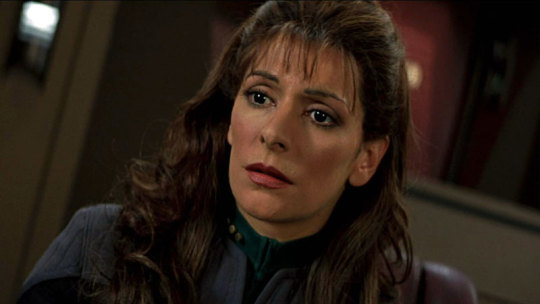
Half Human, half betazoid, Deanna is an empath - meaning she can sense emotions in others. She was Picard's trusted counsellor on the USS Enterprise-D (and E), and eventually married his first officer Will Riker. Throughout seven seasons of STAR TREK: THE NEXT GENERATION, four movies, and some guest spots on VOYAGER and ENTERPRISE, Troi was played by Marina Sirtis.
TORAL ZIYAL
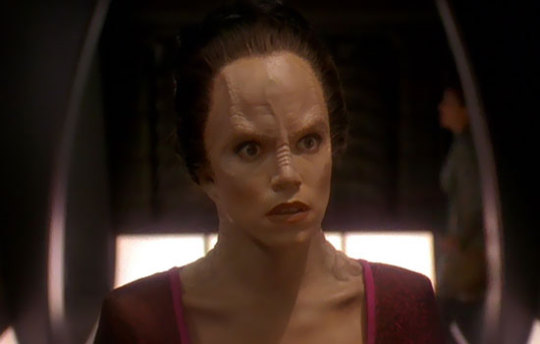
Ziyal spent much of her life as a slave, neglected by her father Dukat due to being half-Cardassian but also half-Bajoran... something his people would never have accepted. She ended up on DEEP SPACE NINE, where she was taken under the wing of Kira Nerys and started developing a romantic relationship with Garak until she was killed by Damar. An act which sent her father a little crazy. A supporting role, Ziyal was played by a number of actors - Cyia Batten, Tracy Middendorf, but most notably Melanie Smith.
DATA
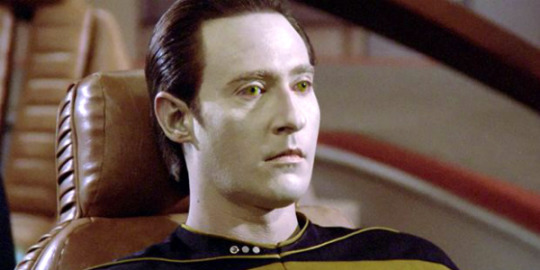
Lt. Commander Data was the first android in Starfleet, and served aboard the USS Enterprise D & E, under Picard, where he spent much of his time studying, and endeavouring to become a part of, humanity. He built up great friendships, in particular with Geordi La Forge. He was an asset to Starfleet, until his sacrifice in STAR TREK: NEMESIS. Data was portrayed by Brent Spiner throughout seven years of THE NEXT GENERATION and four movies.
LORE

Lore was, essentially, Data's evil twin. Unlike Data, he was equipped with an emotion chip from the beginning, but sadly his personality wasn't as promising. He did may evil acts throughout a number of guest spots, particularly when he took control of a dysfunctional faction of the Borg, and tortured Geordi in the process - or worse, got Data (mind controlled) to for him. Like Data, Lore was played by Brent Spiner.
JEAN-LUC PICARD
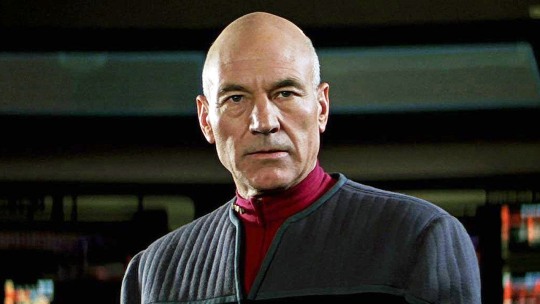
Arguably the best commanding officer in STAR TREK. Some might argue (and there are certainly arguments for the likes of Kirk or Janeway etc) but Picard - as played by Shakespearean actor Patrick Stewart - is easily the most commanding. At first he was uptight and offish, but surrounded by a warm crew, Picard softened over the years... especially after he was assimilated by the Borg as Locutus. Stewart played Picard for seven seasons of THE NEXT GENERATION, four movies, and a guest spot in the pilot of DEEP SPACE NINE.
HIKARU SULU
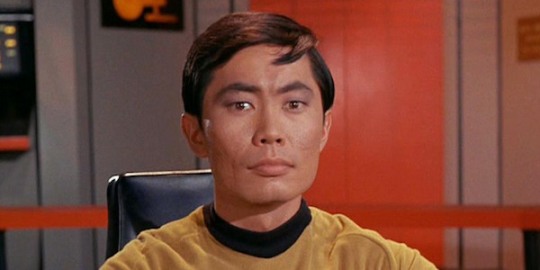
The very first time we met Sulu, he was in the science division, but for the rest of his time in THE ORIGINAL SERIES (and THE ANIMATED SERIES), we was the ship's helmsman. He remained at the helm through three seasons of the live action series, two seasons of the animated, and five movies, until he was finally given his own command. Captain Sulu appeared in charge of the USS Excelsior in STAR TREK VI: THE UNDISCOVERED COUNTRY and again for a guest spot on VOYAGER. He was played by George Takei in all of that, with John Cho playing the character for the Kelvin timeline appearances since 2009.
KURN
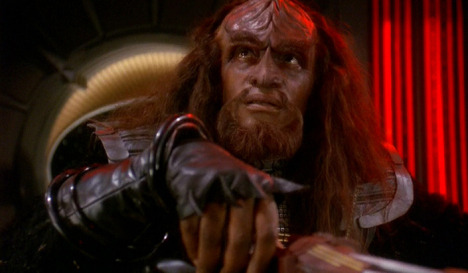
A proud Klingon, Kurn was Worf's brother, and looked down on his decision to join Starfleet. The brothers attempted to turn the dishonoured name of their father into something good again... but when Worf went against Kurn (now a Klingon councillor) over the a Klingon invasion of Cardassia, Kurn had his mind wiped so he would feel Worf's fall from grace. Tony Todd played Kurn in both THE NEXT GENERATION and DEEP SPACE NINE.
CHARLES 'TRIP' TUCKER III

'Trip' was the chief engineer onboard the NX Enterprise. He was a good friend of the commanding officer, Archer, and despite his distrust of the Vulcans, he not only became good friends, but romantically involved with the first officer, T'Pol. The three would often eat dinner together. Connor Trinneer played Trip throughout the four seasons of ENTERPRISE.
KIRA NERYS
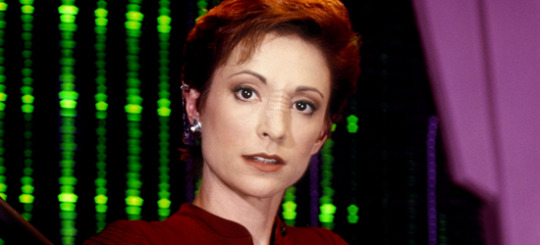
At the start of DEEP SPACE NINE, Kira resented Stafleet's position on the station. She'd been a rebel, freedom fighter against the Cardassian occupation of her homeworld, Bajor and felt Starfleet was another oppressing force. She lightened up though and over the years Kira came to trust and value Sisko and the other Starfleet officers. Kira was played by Nana Visitor over the course of all seven seasons of DS9.
HARRY KIM
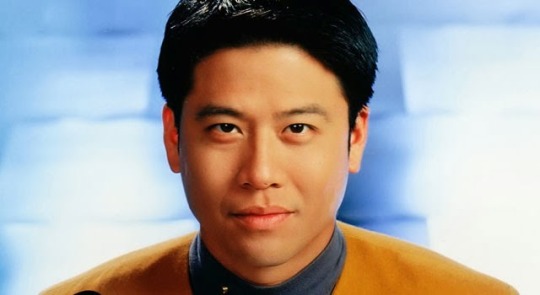
When the USS Voyager was flung across to the Delta quadrant, young naïve Harry Kim stepped up. He was the Operations officer on board and became a valued member of Janeway's crew. He formed a strong friendship with Tom Paris, the two often hanging out in the holodeck. Harry was played by Garrett Wang for all seven seasons of VOYAGER.
WESLEY CRUSHER

Some people found the Wesley character annoyed, but come on, I dare you not to feel a little bit proud when he first walks on the bridge in his Starfleet uniform. Wesley, son of Dr Crusher, was a child genius, and applied (but missed) his chance at starting Starfleet courses, so Picard gave him duties on the USS Enterprise. Wil Wheaton played Wesley for a full three seasons of THE NEXT GENERATION, and left part way through the fourth. He made guest appearances in the seasons that followed, including a cameo in STAR TREK: NEMESIS.
JANICE RAND
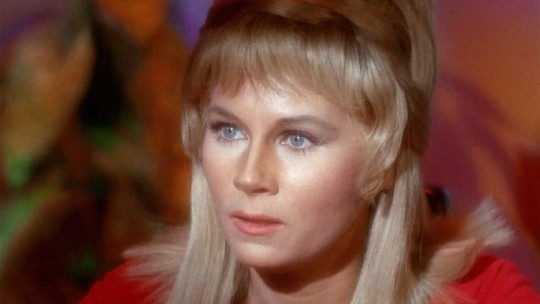
Grace Lee Whitney played Kirk's yeoman. Despite appearing in a lot of the promotional images for STAR TREK, Janice Rand only appeared in the first bunch of episodes. She did appear in cameos across the movies though, last seen on the USS Excelsior under Captain Sulu, in VOYAGER.
LT. KYLE

Lt. Kyle was one of those rare things in THE ORIGINAL SERIES... A red shirt that didn't get killed off. He was played by John Winston across the series as well as an appearance in STAR TREK II: THE WRATH OF KHAN.
SYLVIA TILLY
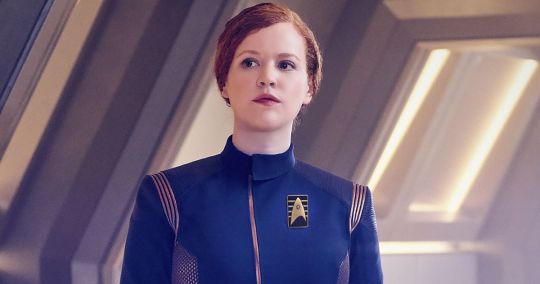
Tilly could be described as the 'heart' of STAR TREK: DISCOVERY. A young and hopeful cadet, Tilly is also determined. She found herself bunking with known mutineer Michael Burnham, but whilst nervous, became her friend - and after proving herself to the rest of the crew, was promoted to ensign, and put on the command track. Mary Wiseman played Tilly during the first season, and will return for the second.
ALYSSA OGAWA

Every good doctor needs good nurses, and Dr Crusher had Nurse Ogawa. Whilst only a supporting character, we got a few nice moments for Alyssa, including an episode (THE LOWER DECKS) which saw a few ensigns looking for promotion and her starting a family. Patti Yasutake played Ogawa from the fourth season of STAR TREK: THE NEXT GENERATION, and went onto the first two movies featuring the same cast.
PHILIPPA GEORGIOU
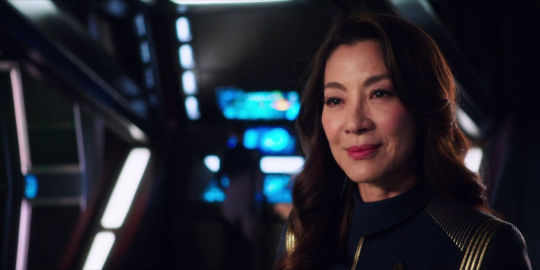
Michelle Yeoh was the first cast member to be announced for the newest of the Treks - STAR TREK: DISCOVERY. Captain Georgiou (commanding officer of the USS Shenzhou) was killed by the Klingons in only the second episode however, with only a hologram of her, reading a message to her first officer Michael Burnham, to follow. That was, of course, until the USS Discovery found itself in in the Mirror universe... and we met Emperor Georgiou. Burnham brought her back to our prime universe, and after pretending to be our Georgiou for a bit, she's disappeared into the shadows. I think we all expect an appearance from Yeoh in the second season - currently shooting now.
So there you are. No new names after this point, this is it. We already have champions from the previous seven batches, and now we need to find one from this batch. You've got three days to pick your favourites - get yourselves to twitter and get voting!
#star trek#all star trek#star trek the next generation#deanna troi#marina sirtis#star trek deep space nine#ds9#cardassian#tora ziyal#melanie smith#data#android#brent spiner#lore#jean-luc picard#picard#Patrick Stewart#locutus#Hikaru Sulu#george takei#John Cho#star trek the original series#star trek the animated series#kurn#klingon#tony todd#charles tucker iii#trip#connor trinneer#star trek enterprise
4 notes
·
View notes
Text
Episode Reviews - Star Trek: The Next Generation Season 3 (6 of 6)
Carrying on our run of episode reviews for Star Trek: The Next Generation, it’s time to look at the last two episodes of the show’s third season.
Episode 25: Transfigurations
Plot (as adapted from Wikipedia):
The Enterprise discovers a crashed escape pod in an unexplored star system. Investigating, they find there is one critically injured passenger in the pod, and the crew brings him aboard the ship. Dr Crusher determines the survivor will live due to the stranger's own amazing recuperative powers. Crusher also notes that the survivor's cells are mutating in some way.
A couple of days later the stranger finally awakens, but has no memory of his life or identity. The crew decides to call him "John Doe". Some time passes and John has recovered physically, but still has amnesia. In addition, from time to time he suffers from severe pain which is somehow tied to his ongoing mutation. He also begins emitting strange, bright energy bursts. John soon learns that he is able to use this energy to heal injuries, as witnessed by Crusher when he aids a patient in her Sickbay.
In the meantime, Geordi La Forge has determined the pod the Enterprise discovered was a kind of storage device. Geordi is also able to interpret a star chart and find the location of John's home planet. However, John's memory has begun to return, and he senses that he must not go back to his home planet yet. A day or so later, a vessel intercepts the Enterprise, and John declares he has to leave. He tries to steal a shuttle and an energy burst accidentally knocks Lieutenant Worf from a walkway, resulting in a fatal fall to the floor below due to a broken neck. John then uses his healing powers to revive Worf and heal his injuries. Prevented from escaping, John explains that he wanted to leave as he is becoming a danger to himself and the crew.
Captain Sunad of the intercepting ship communicates with the Enterprise, announcing he is from the planet Zalkon and that he wants John returned to him. He explains that John is a criminal who has been given a death sentence. Captain Picard considers the situation, but refuses to release John to the Zalkonians without more information as to the charges. He contacts the other ship and mentions John's strange powers, which alarms Captain Sunad. Sunad immediately triggers a device which causes the entire Enterprise crew to become unable to breathe. John resists the device and heals everyone aboard the Enterprise with one bright flash of his energy.
His memory now restored, John transports Sunad to the Enterprise using his powers. John explains that his race has reached a new stage in evolution, in which they are evolving into beings of energy. His homeworld's government fears what is happening and, telling the population it is a deadly sickness, kills any who show the signs of change; John and others aboard the ship were escaping from their homeworld when attacked. John then becomes the first to complete the transformation, becoming invulnerable.
John offers to help Sunad make this transformation as well, but Sunad still refuses. John sends Sunad back to his own ship, warning him that their government can no longer keep their people in ignorance. The Zalkonian ship then leaves the area. John bids the crew good-bye, transforms into energy and departs the ship. While it's not known where John went, the implication is that John left for his homeworld so that other Zalkonians would have the chance to evolve and join him.
Review:
As with quite a few other TNG episodes I’ve reviewed to date, we’re getting a lot of story or concept theft from the world of Marvel’s X-Men. The whole concept of the guest alien undergoing a sudden evolutionary change and exhibiting powers beyond their control reads like a classic X-Men storyline if ever there was one, and I have to wonder if Star Trek would have even made the effort a few years later once the classic X-Men animated series began to air. That being said, the episode isn’t bad; it’s just fairly unoriginal, save for some of the effect the guest character has on Geordi by making him more confident with women. This was a good, and long overdue, development for Geordi considering he was trying to convince Reg Barclay he was ‘just shy’ a few episodes back. Yeah, um, if Barclay’s ‘just shy’, Mr La Forge, then you should be a totally confident lady-killer by comparison. Since La Forge doesn’t become that until his contact with “John Doe”, maybe he should have chosen his words in ‘Hollow Pursuits’ more carefully. This kind of inconsistency is where TNG’s general aversion to larger story arcs is basically showing through. End score on this episode, 7 out of 10.
Episode 26: The Best of Both Worlds (Part 1)
Plot (as adapted from Wikipedia):
The Starship Enterprise responds to a distress call from a Federation colony and arrives to discover the colony gone. The Federation suspect the Borg, cybernetic humanoids that the Enterprise crew encountered over a year ago (in the episode ‘Q Who’).
Starfleet Admiral Hanson arrives onboard the Enterprise with Lt. Commander Shelby, an expert on the Borg, who assists the crew in determining the cause of the colony's disappearance. Hanson informs Captain Picard that Commander Riker has been offered the command of a starship and suggests that Riker take the position, having turned it down twice previously. Although there is tension between Riker and the ambitious Shelby, who wants to take over Riker’s position of first officer, they confirm that the colony was attacked by the Borg. Hanson advises Picard that another Federation vessel encountered a strange "cube-like" vessel before sending a distress call that ended abruptly. Enterprise moves to intercept and confronts a Borg cube.
The Borg demand that Picard surrender himself, which he refuses and is puzzled by; during the initial encounter the year before, the Borg showed no interest in the ship’s screw. Although initially deterred by Enterprise's shield modulation, the Borg lock the vessel in a tractor beam and begin cutting into the hull. Shelby suggests randomly changing the frequency of the ship's phasers to prevent the Borg from adapting to the attack, which frees the vessel. The Enterprise escapes to a nearby nebula, where Lt. Commander La Forge and Ensign Wesley Crusher adapt a technique suggested by Shelby to modify the deflector dish to fire a massive energy discharge capable of destroying the Borg cube. The Borg flush Enterprise from the nebula, board the ship, and abduct Picard. The Borg Cube moves at high warp speed towards Earth, with Enterprise in pursuit.
Riker, now in command of the ship, prepares to join an away team to transport to the cube to rescue Picard, but Counsellor Troi reminds him his place is now on the bridge. Shelby leads the away team onto the Borg cube, where they are ignored by the Borg drones. The team locate Picard's uniform and communicator and then destroy power nodes inside the cube, forcing it out of warp. As the team prepares to transport to Enterprise, they see Picard has been turned into one of the Borg (the first time is seen to have been ‘assimilated’ by the Borg). The Borg contact Enterprise, with Picard stating that he is "Locutus of Borg" and to prepare for assimilation. Riker orders Worf to fire the deflector dish.
Review:
When it comes to episodes that have an impact on their own show and the wider franchise where there is one, ‘The Best of Both Worlds’ holds such status for The Next Generation, and rightly so. Not only is it well-performed, but it brings back the best original villains TNG had produced up to this point, namely the Borg, and used them in a way that fundamentally redefined them and the show that created them in equal measure. As a tech-obsessed threat, the Borg couldn’t have gone very far, since there’d only be so many times you could put the ‘tech’ (namely the Enterprise itself) in danger. Having them develop to also be interested in people and the concept of assimilation driving that suddenly makes the Borg all the more terrifying as opponents, and when they assimilate the commanding officer from the show’s main cast, forcing the first officer to make a very harsh command decision, the show really does seem to be going where no one has gone before.
This episode is where TNG stopped being compared back to the original show all the time and everyone started to accept it as its own part of the wider Trek franchise. A good thing too, since a lot of what gets put into this episode and its sequel impacts down through this series and its spin-offs. It’s also an interesting Riker story because we’re finally looking at why Riker keeps passing up one promotion after another, only for him to suddenly be forced into the command role against his will. Granted, we’ve seen Riker pass up promotions before, but they’ve always done this mid-season and without really focusing on it very well. This time, it’s at the end of a season, and that means the cliff-hanger becomes all the more tense for the first-time viewer. At this point, it’s a toss-up whether Picard is saved and the status quo maintained, or Riker becomes Captain of the Enterprise with Shelby as first officer and Picard lost.
I’m not sure what else I can say at this point, especially considering that there’s a part 2 that needs something in its review when I start tackling the next season. So, for now, I’ll close out by handing down a score of 9 out of 10. This episode gets a lot of points for being game-changing, but it’s Trek without much issue exploration, and I’m always reluctant to elevate Trek episodes that lack such added depth based on impact and performances alone.
0 notes